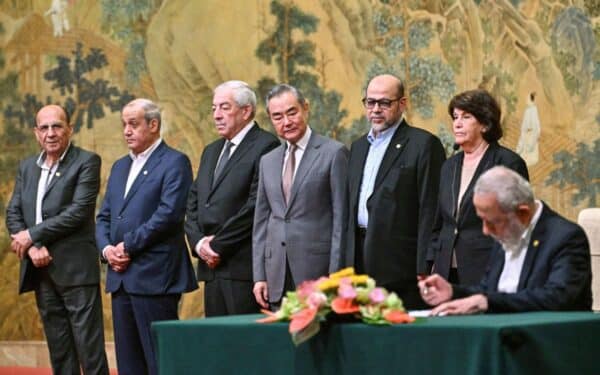The revolution starts here!
Or, one hopes, it started sometime on Monday afternoon when Nick Cave sent out his latest email to fans. In it, he addressed the issue of AI-generated art, in this case, a song written “in the style of Nick Cave” by ChatGPT, an AI-powered chatbot which can create text based on a user’s request.
Cave was dismissive of the result, eventually calling it “a grotesque mockery of what it is to be human”, and his argument leading to that conclusion is worth reading. The problem, however, is that it’s not entirely clear that Cave fully understands the danger of what’s being presented before him. He writes: “This is what we humble humans can offer, that AI can only mimic, the transcendent journey of the artist that forever grapples with his or her own shortcomings. This is where human genius resides, deeply embedded within, yet reaching beyond, those limitations.” The argument which reduces to “this doesn’t come from a human place” is familiar to all of us witnessing this revolution. But it also makes a pretty familiar assertion about “art”, which is often intellectualised in one of two very different ways.
We have, most famously, the notion of art as some divine gift. This is the one Cave routinely offers and it’s unsurprisingly Romantic, even if its origins probably go back to Delphic seers revealing mysteries in ancient Greek caves. This is the sense of creativity curated most famously by William Wordsworth in The Lyrical Ballads. It’s the oft-cited description of poetry as “the spontaneous overflow of powerful feelings: it takes its origin from emotion recollected in tranquillity.”
The other sense of art is more organic and considerably more nuanced. Art emerges from art itself. In this sense, it’s an extension of language. The artist exists in a continuum of influence, not just the work of others they’ve internalised through admiration and emulation, but the work they’ve done themselves. All art is in some sense a copy of other art, adapted by the individual to create something new. If we cannot escape our subjective experience, then we must embrace it for what it is. This is more like the postmodern sense of language, meaning, and… well… everything.
So where does AI come into this? Well, if AI were operating according to the first of these models of art, then we’d have no reason to fear. We could assume that no machine could (as yet) reach out into that transcendental realm where the divine light is to be found. Except, of course, such a realm doesn’t exist (though, of course, dismissing this so lightly ignores the huge debate we could now have, which would ultimately descend into one about religion).
If art is closer to the second model of influence and intertextuality (and I think it probably is), then it’s here where the AI bots will run amok.
Glossing over the fact that “AI” remains a terrible term for something that isn’t any form of intelligence, these AI bots are very skilled in one or two specific tasks. First, these algorithms have access to a huge corpus of data which they can interrogate at speed. Let’s say they have access to hundreds of thousands (if not more) of images of a sunflower. The bots contain distinct mechanical processes. One part can create images based on sets of data. The other part can look at the resultant image and rate the degree to which that image could fit inside that data set. One algorithm creates. The other critiques. You then have what is called a “competitive network”. One part of the network creates and the other, in a sense, deconstructs. Allow these two parts of the network to feed off each other, to battle long enough, and you eventually get a result that should, in theory, look like a sunflower. Yet it won’t look like any sunflower in the dataset. It will be a unique sunflower. Yet also similar.
This is to grossly oversimply what’s happening, but the point is that the network doesn’t at any point understand what a sunflower is any more than it understands the colour yellow, or the career of an artist called Vincent van Gogh. It does, however, spot similarities across all the images to allow it to, in a very abstract sense, understand the essence of sunflowers. It manages to extract some “sunfloweryness” from the data.
We can quickly get into the weeds of the philosophy of this, but the point here is to note that the results are already hugely impressive. They are already hugely problematic, especially for anybody trying to earn a living in a creative industry.
The first point at which this will be (and in truth, probably is being) felt is anywhere where artists are commissioned to provide images for articles. Already newspapers are using bots to produce free graphical content rather than pay illustrators. We’re also seeing AI making headlines inside art circles. Recently, the photographer Siobhan Walker used AI to create some photographs of working-class families living in Glasgow in the 1980s. There was nothing too uncanny about the results. One might have easily mistaken them for a roll of undeveloped film that had been discovered among the (brilliant) social documentary work that Raymond Depardon did around Glasgow in the 1980s. The general public was impressed with Walker’s efforts. Photographers were not. On Twitter, Marc Davenant responded: “If you are using AI to create your images then you may be many things but you are not a photographer.”
Unfortunately, though, it does not ultimately come down to photographers, songwriters, or any other artist to determine what is or isn’t art. The factor not spoken about too often is the one that is perhaps the most dangerous.
The term “reader response” will be familiar to anybody who has studied literary theory. It’s the argument that it’s the reader who brings the meaning to any text (or work of art), rather than the original artist. Readers/viewers also imbue work with value. One of the most famous practitioners of this approach to critical theory, I.A. Richards, would give his students poems to interpret but missing the key facts such as the author’s name. He understood how much the name “Shakespeare” or “Shelly” attached to a poem influenced how a student would read the poem, often far less critically than if the name were that of an unknown.
It might well be the case that it’s this “name” factor that will protect some of our artists from the encroachment of the imitative bots (Nick Cave will not suffer from bot imitators any time soon) but, at the same time, our society soon is going to be swamped with the artificial and free and if the public like what they see, this demand will only grow and may leave little room for the work of humans. There will also be room for celebrities to use bots to create work which they will pass off under their name. Those headlines can’t be far off.
Anybody committed to art would, of course, be foolish to allow that to happen yet, at the same time, it’s hard to imagine how it can be stopped. The most obvious method would be to use existing copyright laws. At the heart of this revolution are these large data sets, at the moment containing many copyrighted images of artists living and dead. If the AI bot has access to the work of a living artist, then the bots can imitate that artist. Without that dataset, the bots can create nothing.
And that might be the only weakness of AI art as well as the moral argument against it. Even though every work is unique, the process leading to that creative act is not. In “learning” an artist’s style, the AI absorbs everything that the artist has ever done to formulise an aesthetic. This isn’t old-fashioned notions of copying but something deeper and, ultimately, far more distressing. And this is where Nick Cave does have it right. It is “a grotesque mockery of what it is to be human” because it is taking the results of a lifetime of learning, suffering, loving, and living to find a shortcut to creativity. AI (and its users) will now reap the benefits without any struggles to get them there. It punishes humans for being human, turning our pain and suffering into nothing but pastiche.
Worse still, it discourages humans from taking up a pen, pencil, paintbrush, stylus, or guitar. If AI can do it for us and with a degree of mastery that very few of us will ever achieve, why should we humans even bother?
Write to us with your comments to be considered for publication at letters@reaction.life
Follow David on Twitter: @DavidWaywell




